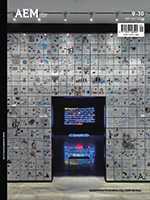2025년 11월호 지면기사
/ Sarada Vishnubhatla_sarada@autoelectronics.co.kr
.jpg)
Harikrishna Khandavilli
Head - Engineering (Bangalore)
& Head - Engineering Software (APAC) – Architecture and Network Solutions
Aumovio India
SDVs are now beginning to take firm root in emerging markets such as India. The shift to SDVs brings unprecedented technical complexities, extended development cycles, and escalating costs. It demands resilience from the collective industry to resolve these challenges and make the vehicles user-friendly despite inevitable setbacks, at least initially.
AEM’s Senior Editor, Sarada Vishnubhatla talks to Harikrishna Khandavilli, Head - Engineering (Bangalore) & Head - Engineering Software (APAC) - Architecture and Network Solutions, Aumovio India and gathers insights into the company’s global SDV strategies and their offerings to the domestic ecosystem in the domain of SDVs.
Harikrishna Khandavilli shares that as a global technology leader Aumovio is positioning India R&D Centre as a key driver in its SDV strategy. From high-performance computing architectures to cybersecurity, Aumovio India is working with major global and Indian OEMs and is influencing how vehicles will be conceived, built, and experienced worldwide in the not-so-distant future.
by Sarada Vishnubhatla_sarada@autoelectronics.co.kr
한글로보기
The demand for the latest features and technologies is constantly increasing. Today, people want their vehicles to include the latest features, providing them with the comfort of their homes.
Cars today have multiple electronic control units that are critical for the functioning of the vehicle. They control all aspects of safety, like autonomous braking, airbag deployment, and other features like connectivity, navigation and remote diagnostics that help in vehicle maintenance. It is literally transforming an electro-mechanical mode of transport into an intelligent, constantly upgradable and highly convenient electronic mode of transport.
Khandavilli shares, “Today’s cars have 150 to 200 million lines of code, and by 2030 this is expected to touch 600 million. We will also have many more devices connected to the internet. The SDV’s are just emerging, and they will continue to evolve over the next decade, creating a potential value of more than $650 billion for the auto industry by 2030, making up 15-20 per cent of the automotive value.”
The electronic architecture of the modern vehicle is transforming with a few powerful servers replacing the many individual control units. They will eventually supply the vehicle's functional domains with the necessary computing power. SDVs require change in electric / electronic (E/E), and software architectures based on the decoupling of hardware from the software, enabling swift and continuous development and implementation of new functions and software updates throughout the vehicle lifetime.
He adds, “Aumovio understands the importance of HPCs and is firmly driven to move past the traditional ECU systems that are currently in place. Our aim is to ensure that 75% of all HPCs function as cross-domain tools and more as servers. This is in line with the fact that modern cars today resemble moving data centers.”
Overall, Aumovio’s HPC concept is divided into four application areas: the Cockpit HPC, which interacts with the driver, the Body HPC that regulates the data streams in the vehicle and serves as an intelligent interface to the internet, cyber security and communication, the automated driving (AD) version of the HPC and the Safety HPC. A central driver of the transformation of the E/E architecture from multiple ECUs to an HPC server infrastructure is the introduction of a new intermediate layer with zone control units. ZCUs can be used to ‘clean up’ the existing E/E architectures to reduce the number of ECUs and the weight of the wiring harness.
“The more the central computing power of the vehicle is being concentrated in a few HPCs, more important become the zone controllers that ensure the reliable execution of the vehicle functions,” he explains.
Each ZCU integrates functions from different domains in a specific zone and serves as a hub for the power distribution and data connection requirements for the connected devices.
Global SDV Landscape
and Regional Variations
Across the world, different regions are at different stages of SDV adoption. In Asia, China leads with advanced deployments — Body, Cockpit, ADAS, and Vehicle High-Performance Computers (HPCs) integrated into Server Zone vehicle architectures. OEMs in these geographies already operate with an ecosystem built for the SDVs.
In Europe and North America, the shift is accelerating which is led by major brands who are already planning major SDV moves by 2026. Aumovio has long supplied ECUs for these OEMs, initially in domain HPCs like Body and Cockpit applications, and is now progressing toward fusion and integration of HPCs like x-Domain HPCs.
.jpg) Khandavilli said, “Aumovio deeply understands the importance of High-Performance Computers (HPCs) and is ready to move beyond traditional ECU-based systems. Our goal is to transform more than 75% of all HPCs into cross-domain, server-like systems. This strategy reflects the reality that today’s vehicles are essentially becoming ‘moving data centers.’
Khandavilli said, “Aumovio deeply understands the importance of High-Performance Computers (HPCs) and is ready to move beyond traditional ECU-based systems. Our goal is to transform more than 75% of all HPCs into cross-domain, server-like systems. This strategy reflects the reality that today’s vehicles are essentially becoming ‘moving data centers.’
India- Nascent yet Adaptive Market
India is at a nascent stage in the SDV context. Even the dominant domestic OEMs are moving cautiously due to the cost-sensitivity of the market.
Khandavilli says, “Transitioning in the short-term, sudden upgrades to SDV architectures risk impacting their competitive positioning, so most are opting for gradual integration.”
Significant HPC adoption — especially for Body, ADAS and Cockpit systems — is expected from 2028 onwards. That said, some leading OEMs have already launched EVs with Server Zone architectures, and others are advancing rapidly with HPC integration. Aumovio Continental is working closely with major OEMs in sync with their pace, and as per their outlook of the market.
Giving this a fillip, central government’s initiatives, such as the National Electric Mobility Mission Plan (NEMMP) and the Faster Adoption and Manufacturing of Hybrid and Electric Vehicles (FAME) scheme, are fostering an environment conducive to the adoption of SDV technologies.
Aumovio’s SDV Technology
Aumovio’ s Software Defined Vehicle (SDV) technology is primarily developed through a global network of R&D centers, with significant contributions from Technical Centre India (TCI), one of its largest research hubs.
SDV development involves a collaborative effort, combining expertise from global and regional centers to meet diverse market needs.
Aumovio’s global R&D centers, including those in Germany, and the US along with Technical Center India (TCI), focus on creating the core SDV architecture, including software platforms, autonomous driving technologies, and connectivity solutions. These centers develop high-level systems like autonomous driving (L0-L4), cloud services, and cybersecurity, providing the framework for SDV advancements worldwide.
Strategic Partnerships and Collaborations
Technological, organizational, and cultural innovations pave the way for SDVs. Partnerships play a crucial role in the development strategy of SDVs as they enable collaboration across the automotive and technology ecosystems.
By collaborating actively with technology providers, startups, and industry leaders can help leverage specialized expertise, accelerate innovation, and ensure seamless integration of software solutions. Partnerships enable one to scale solutions faster, enhance customer experiences, and meet evolving regulatory and market demands effectively. They also help come up with standards and various organizations today are opening new open source working groups to shape the transformation in automotive software.
He explains, “We partner with various companies including Amazon Web Services (AWS) to power the CAEdge framework, and our modular solution for service-oriented vehicle architectures. Also, our collaboration with Google Cloud helps us to redefine the driving experience through the integration of generative artificial intelligence. Our collaboration with Telechips, a Korean semiconductor company, supplies Aumovio with its Dolphin System-on-Chip (SoC) family.”
The Dolphin SoC is adapted to the pre-integrated function set of the Smart Cockpit High-Performance Computers (HPCs) and offers ideal system performance for cluster, infotainment and visualization of Advanced Driver Assistance Systems (ADAS).
.jpg)
Addressing Cybersecurity
and Complexities
With increased connectivity comes the ever-lingering threat of cyber-attacks. In 2023, India recorded 2,138 weekly cyberattacks per organization, a 15 per cent increase from 2022. This highlights the importance of robust cybersecurity, especially in the automotive sector with the connected car being a future norm.
Aumovio is developing end-to-end solutions with the aim of always ensuring the highest possible degree of security.
Khandavilli shares, “We have a proactive approach that takes cybersecurity into account right from day one in product development, so that potential security loopholes do not arise in the first place. We conduct a detailed risk analysis for new projects to ensure secure products and services that comply with the regulations. We refer to this process as 'security and privacy threat analysis, risk assessment and risk treatment', and we consider not only the initial development but also the entire product life cycle.”
The Korean Connection
Traditionally, the Korean market has been geared towards future readiness in automotive technology. The highlight of the Korean OEMs has always been the fact that before making a full transition to software-defined vehicles, they work on body domain controllers — an intermediate step that delivers many of the same functions while allowing them to move cautiously, yet effectively, towards SDV architecture. This approach reflects their philosophy of playing safe, but always delivering strong value to the customer.
The top passenger car brand from Korea has the latest features, superior comfort factor and safety system. The ride comfort in these cars is noteworthy. This brand has a deep understanding of the customer needs.
He points out, “Our team in Korea is closely working with their OEMs for their architectural adaptation towards SDVs. Aumovio India R&D team is a major partner for SW & System development along with the R&D team in Korea.”
This collaboration is majorly driven by the shared interests between Indian and Korean markets, making it a win-win situation.
The Future of Mobility
The Software-defined Vehicles re-define the value of the car. In other words, the end user is at liberty to change or enhance the key functions and the nature of the devices by software – epitomizing the euphemism ‘Customer is the King’.
In a nutshell, it is all about -
· time to market for software innovation
· decoupling lifecycles of parts that inherently have different timelines
· managing complexity
· changing development practices
· changing business models
· server-zone architecture
· data driven to improve safety and user experience
In this way, Aumovio is building the core infrastructure for the Software-Defined Vehicle (SDV) era through high-performance computing (HPC), AI, and global collaboration, leading future automotive innovation in markets including India and Korea.
Prashanth Doreswamy on the Future of SDV and Aumovio India’s Role
[AEM] Automotive Electronics Magazine
<저작권자(c)스마트앤컴퍼니. 무단전재-재배포금지>




.jpg)
.jpg)
.jpg)

